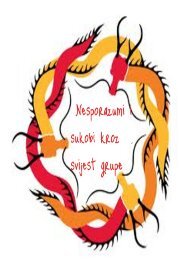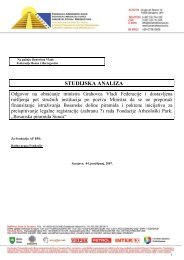The Complete Guide To Mysterious Beings - Galaksija
The Complete Guide To Mysterious Beings - Galaksija
The Complete Guide To Mysterious Beings - Galaksija
You also want an ePaper? Increase the reach of your titles
YUMPU automatically turns print PDFs into web optimized ePapers that Google loves.
placed in his Chorten after his death.<br />
Many of the mountain lamaseries cherish bits of Yeti hair and bones as sacred relics. <strong>The</strong>y think<br />
Yetis are devils posted around the mountains to guard the gods who supposedly live on the summits.<br />
In the fall of 1954, a tribe of headhunters in Assam reportedly killed and ate a creature ten feet tall.<br />
<strong>The</strong> bones and fur are supposed to have been carried off to a monastery.<br />
Tenzing has never seen a Yeti personally but he does not question its existence. His father claims to<br />
have once met one face to face and managed to escape. Tenzing said his father wasn't a liar or given<br />
to making up wild tales. And his description correlates with the reports of other eyewitnesses.<br />
Almost every expedition into the more remote sectors of the Himalayas in the past fifty years has<br />
seen and photographed the huge ABSM footprints. Usually such prints are found in the snow at<br />
high altitudes which are beyond the reach of most ordinary animals. After all, animals are not likely<br />
to venture into areas where no food or prey can exist. Samples of Yeti droppings have also been<br />
collected and studied and indicate that it lives on a small rodent known as the mouse-hare. A<br />
number of expeditions have produced reliable reports of having seen the beast itself from a distance.<br />
It has been seen digging up roots with a stick, something no ordinary animal would do. This use of<br />
a tool puts it in a subhuman class.<br />
What could it be? <strong>The</strong>re is some evidence that it might actually be a survivor of the early<br />
Neanderthal man. Footprints known to have been made by Neanderthalers have been discovered<br />
and they are almost identical to the ABSM tracks. In 1948 an ancient cave, long sealed by volcanic<br />
lava, was opened near <strong>To</strong>irano, Italy, and it was found to contain all kinds of interesting artifacts,<br />
including the footprints of modern-type men, giant bears, and Neanderthalers. <strong>The</strong> latter tracks were<br />
immediately recognized as being almost exactly the same as the footprints photographed by the<br />
various expeditions to Everest. Of equal interest was the fact that the discovery seemed to indicate<br />
that modern man and the Neanderthalers existed in the same era. A fact which led the Type B<br />
scientists to quickly shuffle the discovery into the back of their files.<br />
In the 1950s an expedition in the Middle East unearthed relics which suggested that modern man,<br />
Cro-Magnon man, and Neanderthal man had all existed at the same time. This, too, was quickly<br />
swept under the carpet by the pro-evolution types. After all, if these various human and subhuman<br />
personages all lived together in a single epoch then there is something radically wrong with our<br />
long-accepted evolutionary scale.<br />
<strong>The</strong> evidence we are summarising here opens a whole new anthropological bag. Could the ”Wild<br />
Men of the Woods” of Europe have been stray survivors of some ancient time, gradually driven<br />
further and further back into the forests and mountains, forced to mate with human females in order<br />
to survive at all, and, finally, pressed into extinction when human females were no longer readily<br />
accessible? Could these hairy beings have survived in the remote fastness of the Himalayas and the<br />
deep jungles of Brazil and northern Canada?<br />
We have seen the Yeti footprints for ourselves. We have even tried to track the animal down to his<br />
lair. In Jadoo, this adventure was fully described. Here is a summary of that narrative: [Jadoo by<br />
John A. Keel, published by Julian Messner, Inc., 1957. Out of print.]<br />
While traveling through northern Sikkim with a native guide named Norbhu, we heard the Yeti's<br />
distinctive call which ”sounded like a bird very near, short chirps with a slight warble. Similar to<br />
monkey chatter but higher pitched and less defined.”<br />
We were very close to the border of Tibet, and soon found definite Yeti tracks. ”<strong>The</strong> tracks were<br />
clear and spaced at a leisurely pace. It was definitely not an ape or bear, and the prints were much<br />
too big to have been made by a barefooted man... <strong>The</strong>n suddenly, from somewhere in front of us,<br />
there was a sharp animal scream; brief, filled with tearing pain. Norbhu jumped a foot. <strong>The</strong>n there<br />
was only silence and the drip of water on the leaves overhead.<br />
”A little further on a group of natives appeared and led us to their village on the brink of a narrow<br />
river. <strong>The</strong>y'd heard the scream, too. It was a panther, they said. A dying panther.... <strong>The</strong>y had found a<br />
bloody spot surrounded by Yeti tracks. <strong>The</strong>y were rushing back to their village when they bumped<br />
into us.<br />
”Could a Yeti kill a panther, I asked?










